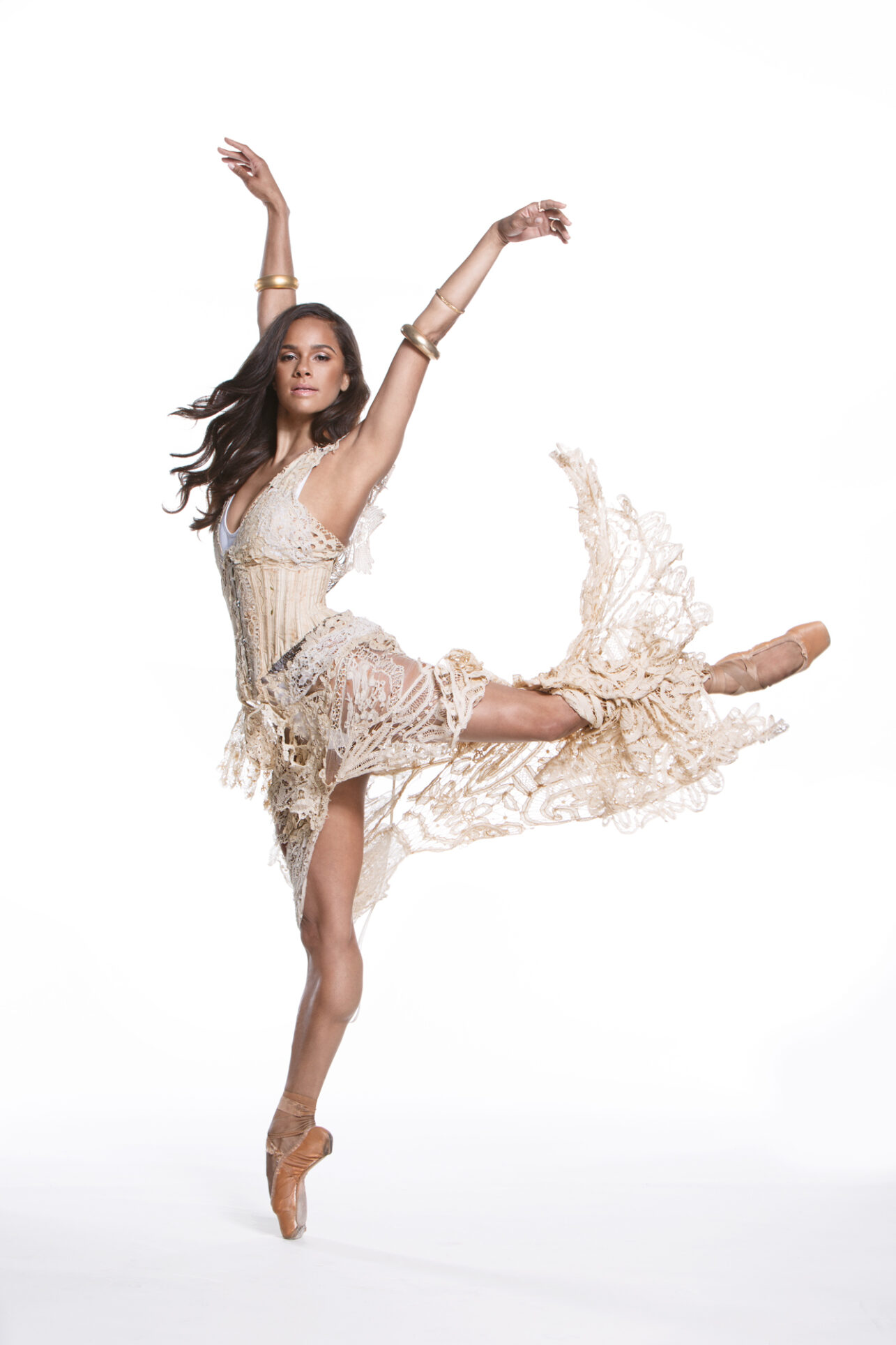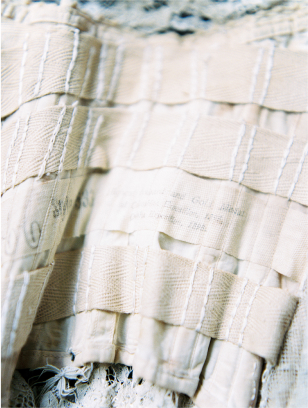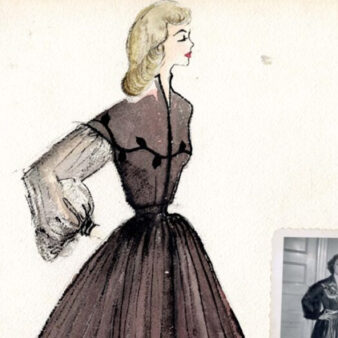

Mimi Prober, Fashion Design ’12, still has one of the showstoppers she made for her critic award–winning senior thesis collection—an ethereal gown made with scraps of antique lace and a vintage corset.

“Misty Copeland danced in it,” Prober says, referring to the American Ballet Theater star, who donned the dress while whirling about en pointe for a photo shoot. Several other women have put it on since. Most recently, singer-songwriter Alexa Ray Joel, a client and good friend, wore it at an event right before the coronavirus pandemic hit New York, in 2020.
“It’s had a history,” Prober says.
You can say that of all of Prober’s pieces. The Miami-born designer stitches and drapes antique lace, 19th century friendship quilts, and vintage woven textiles into exquisite “modern heirlooms”: funky patchwork motorcycle jackets, exuberant embroidered tapestry coats, delicate-but-tough tie-dyed neo-Edwardian lawn dresses. (She uses every last scrap of fabric, leaving no waste.) Each element has its own unique story and tie to the past.

She credits her French-Moroccan grandmother for her love of old things. “She always had the most fabulous vintage pieces,” Prober recalls. “Her original clothing from when she was in Morocco was custom made from a family seamstress, and I think she carried that appreciation and value of the handmade to me.”
In high school, Prober enrolled in fine arts, and mainly did abstract painting and some collage, but in her spare time she haunted thrift stores, searching for discarded treasures she could deconstruct and transform. She continued to work that way at FIT. While her classmates went to Mood for their fabrics, Prober attended auctions, searching for hand-stitched lace from the 18th to early 20th centuries, which she used for her romantic dresses.
“Sustainability wasn’t really defined [at that time],” Prober says. “It was kind of like an intuition for me.”

Since launching her eponymous label in 2014, she has expanded her zero-waste methods beyond vintage materials. Now she works with artisans, farmers, and mills to create her own textiles, too—always with an eye toward the past, such as a recent collection of T-shirts screenprinted with the poster art for a 1971 “Return of Spring” concert featuring the Grateful Dead and others that her “hippie” father created and produced.
“The vintage textiles are very important—and they’re near and dear to me to preserve that history,” Prober says. “But I also want to make sure we’re bringing it forward and preserving these crafts.”
Antique bedclothes
One of Prober’s most prized possessions is an antique handwoven coverlet, dark blue with a cream floral pattern, signed and dated 1835. “What’s really special about these coverlets is they were woven on large floor looms in the 1800s, sometimes woven by families or traveling weavers,” who passed down the craft from generation to generation, Prober says. But since they’re close to 200 years old—and have likely covered several beds—they’re a bit time-worn.
Prober preserves these coverlets and turns them into luxurious coats, which remain some of her best-selling items. One example has the weaver’s signature and the year 1842 stitched on the corner. It’s definitely a statement topper. “It makes such an impact and hopefully will pass on from generation to generation, too.”
Farm-raised felt

Prober works with various artisans and farms to create textiles and natural pigments, including Japanese indigo grown on an upstate New York farm belonging to Jeffrey Silberman, retired professor of Textile Development and Marketing.
For her soft hand-felted coats, she uses wool from the paco-vicuña, similar to an alpaca, raised on a family-owned sustainable farm in Missouri. “They’re not only super, super sweet, but they have the softest fiber,” Prober says. “In the textile world, it’s as valuable as gold.”
Prober ships the paco-vicuña fiber to an upstate New York farm to create a unique hand-felted textile that has some of her antique lace bits embedded within. “I go to the farm to hand-felt, and it’s just a beautiful experience to really see where your fiber comes from,” she says. Nomi Kleinman, chair of the Textile/Surface Design Department, wove one of these paco-vicuña garments for Prober. “Obviously my connection with the school didn’t end at graduation!” Prober says.
Crazy quilts
“If I were to pick a textile that says everything about our philosophy, it would be the crazy quilt. … It’s really the first zero-waste textile.”
Crazy quilts—made primarily by women starting in the 1800s—comprise leftover scraps of other textiles and quilts, intricately pieced together. These quilts can take years to finish, and often include signatures and other mementos that make each finished product idiosyncratic and personal. “It’s just such an important textile,” Prober says. But while the best of these quilts now hang in museums, plenty more are too worn, frayed or damaged to be displayed on their own. Reviving these much-loved pieces and the tradition they come from “is really special to me,” Prober says.
Prober used portions from two 19th-century crazy quilts to create a patchwork motorcycle jacket, displayed through September 5 in The Metropolitan Museum of Art’s exhibition In America: A Lexicon of Fashion.
“I liked the idea of bringing an antique textile into a classic modern silhouette,” Prober says of the jacket. On the front is an embroidered “M”; on the back is the date 1913, from one of the original quilts. “I love when I find [pieces] with my initials [on them].”

Lace fragments
Mimi Prober, the brand, started with lace. She keeps a collection of preserved antique lace in her atelier, including a sample made by a 10-year-old girl named Nancy Lovett around 1787.


For her first corset gown, created at FIT, Prober stitched together dozens of lace snippets that she found at various auctions and shops along the East Coast, some dating back to the late 1600s. “These are tiny, tiny fragments,” she says. “There isn’t one textile on here that is newer than the 1920s, though most of it is from the 1800s.” She draped these bits onto a late-19th century corset that she spent hours preserving and restoring—hand-embroidering and reinforcing its structure using antique thread, a skill she learned in her haute couture techniques class at FIT.
The lace corset dress has become something of a signature style for the brand, and Prober released an updated take on the gown using natural-dyed lace in her latest spring collection.
“I think it says something that my thesis piece is still very meaningful to me,” Prober says. “It’s not something that’s been thrown in the back of my closet or up in an attic. It’s still very much alive.”
